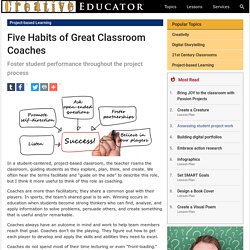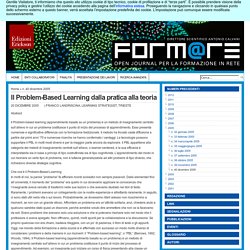

Rubrics for Assessment. How Do I Create Driving Questions for my projects? Cambiare i paradigmi dell'educazione. La grammatica delle immagini e dei video: Introduzione. La grammatica delle immagini e dei video: Trasformare una storia scritta in una storia ad immagini. Five Habits of Great Classroom Coaches. Foster student performance throughout the project process In a student-centered, project-based classroom, the teacher roams the classroom, guiding students as they explore, plan, think, and create.

We often hear the terms facilitate and “guide on the side” to describe this role, but I think it more useful to think of this role as coaching. Coaches are more than facilitators; they share a common goal with their players. In sports, the team’s shared goal is to win. Winning occurs in education when students become strong thinkers who can find, analyze, and apply information to solve problems, persuade others, and create something that is useful and/or remarkable. Coaches always have an outcome in mind and work to help team members reach that goal. Coaches do not spend most of their time lecturing or even “front-loading.” The project building process minimizes how much of the teacher’s time is spent directing the class from the front of the room. The best coaching involves: 1. 2. Metodologie didattiche a confronto – Progetto di ricerca sulla mappatura delle metodologie didattiche attive.
The Jigsaw Classroom. Elliot Aronson is currently Professor Emeritus at the University of California in Santa Cruz. He has long-standing research interests in social influence and attitude change, cognitive dissonance, research methodology, and interpersonal attraction. Professor Aronson's experiments are aimed both at testing theory and at improving the human condition by influencing people to change dysfunctional attitudes and behaviors. Professor Aronson received his B.A. from Brandeis University in 1954, his M.A. from Wesleyan University in 1956, and his Ph.D. in psychology from Stanford University in 1959. He has taught at Harvard University, the University of Minnesota, the University of Texas, and the University of California.
Didatticapersuasiva. Apprendimento Basato sul Progetto (Project Based Learning): Apprendere dalle Esperienze. Cos’è il project based learning?

Il PBL è un approccio all’insegnamento che pone maggiormente l’accento sull’apprendimento da esperienze complesse, orientate verso il raggiungimento di uno scopo o di un obiettivo specifico, al contrario dell’approccio accademico tradizionale che promuove la memorizzazione meccanica di molteplici nozioni alienate dai loro usi concreti nel mondo reale. L’obiettivo che si pone il PBL è quello di fornire alle giovani generazioni gli strumenti mentali necessari per far fronte alla complessa e mutevole natura dell’economia basata sull’informazione che dovranno prepararsi ad affrontare.
PBLWorks Project Planner v2019 Notes. PBL Mario Rotta. What is Inquiry-Based Learning? Metodologie Attive: Il Problem Based Learning. Piante a Rischio. Il Problem-Based Learning dalla pratica alla teoria. Abstract Il Problem-based learning (apprendimento basato su un problema) è un metodo di insegnamento centrato sull’allievo in cui un problema costituisce il punto di inizio del processo di apprendimento.

Esso presenta numerose e significative differenze con la formazione tradizionale. Il metodo ha trovato vasta diffusione a partire dai primi anni ‘70 e numerose ricerche ne hanno confermato i vantaggi. Le tecnologie possono supportare il PBL in molti modi diversi e per la maggior parte ancora da esplorare. Il PBL appartiene alla categoria dei metodi di insegnamento centrati sull’allievo, o learner-centered, e la sua efficacia è interpretabile sia in base a principi di tipo costruttivista sia di tipo cognitivista. La metodologia PBL. Metodologie Didattiche: Apprendimento basato su Problemi, sull'Indagine o sui Progetti.
Digital revolution in the classroom. STEM MI Champions: Leading Project-Based Learning / PBL Gallery. Home | Getting Started | Modules | Resources | About Us View the work of teachers who developed and implemented PBL units/mini-units.

Feel free to download and use the PBL as a template for your work with students. We appreciate your feedback. View additional middle school projects on the STEM-MI Champions Gallery page. Project Based Learning: Explained. Un docente inclusivo. Le raccomandazioni lettura Pearson. Project Planner. Start planning your next PBL project with confidence, using this step-by-step form as your guide. Why is a project planner important? When you’re ready to design a project for your classroom, it’s helpful to have a framework to capture your ideas and organize your plans. A Gold Standard PBL unit has a lot of pieces to plan: your goals for student learning, entry event and driving question, major product(s) students will create, daily lessons, and more. It’s also a good idea for a school to use a common framework for PBL unit planning, so teachers can collaborate using the same language, and share projects more easily with colleagues.
So we’ve created a Project Planner to support you in the planning process. The Project Planner has five parts: 1. 2.